Tōkyō Area JR Freight Locomotives
Most freight trains in Tōkyō are hauled by electric locomotives, although Diesel-Hydraulic DE10 road-switchers are sometimes used, and industrial locomotives work yards and port/industrial track (and some of these are equipped for mainline operation). Most of these trains are short by North American standards, only a dozen or two cars. Unit trains, container flats or petroleum tank trains for the most part, dominate. There are still some commodities, such as paper, that travel by boxcar, and a few other types of cars are in use, so there are some mixed-freight trains.
Locomotives other than industrial switches in Japan are given a model number based on propulsion, axle-count, and speed. A two-letter code is used, the first identifying their type (“D” for diesel, “E” for electric, and recently “H” for “hybrid” diesel/battery models) and the second number of powered axles (“D” for 4, “E” for 5, “F” for 6, “H” for 8), suffixed by a number to differentiate one from another, with numbers less than fifty used for locomotives with restricted top speeds, and higher numbers indicating locomotives capable of at least 110 kph. However, JR seems to be numbering all new models above 200. As all can do at least 110 kph this doesn’t alter the old numbering scheme, it just extends it.
Thus a DE10 is a low-speed (number less than fifty), diesel-powered (“D”), five-axle (“E”) locomotive. And an EF210 is an electric, six-axle, high-speed locomotive.
Note that axles are typically arranged in pairs, so a six-axle unit will have three trucks with two axles each, rather than two trucks of three axles as is common in the U.S. and Britain. Also note that because only powered axles are counted, there are a few six-axle locomotives of type B-2-B (two powered trucks with a center idler truck) that are identified as “D” rather than “F” (e.g., the DD51 and the ED76).
Depots
Several locomotive depots are located around Tōkyō, to supply and maintain motive power for freight trains. Some of these also service passenger trains (and some passenger trains are locomotive-hauled).
Omiya Depot on the Tohoku Main Line just north of the city (in Saitama) services some locomotives, presumably those in use on this line, although I haven’t found any references to freight locomotives being assigned there.
Tabata Depot, on the north side of the city (in Kita ward) services locomotives from the Jōban and Keihin-Tōhoku lines and the Sumidagawa Freight Terminal. These include DE10, EF64, EF65-1000, EF81 and EH500 models. The Oku Rolling Stock Center (Japanese wikipedia) is associated with it (and possibly collocated with it, although that isn’t clear).
Shin-Tsurumi Depot, on the south side of the city (actually in Kawasaki), services locomotives from the Tōkaidō Main Line.
Shinagawa Locomotive Depot is adjacent to Shinagawa Station, just south of Tōkyō Station. This appears to be only for passenger trains.
Tamachi Vehicle Center is associated and located with the Shinagawa Depot, and services passenger trains operating on the south side of Tokyo, including the 251 series Super-view Ororiko. A cryptic note on the Japanese wikipedia page for the Oku Vehicle Center suggest it is closing in 2013, with trains being transferred to Oku.
Electric Locomotives
Most freight locomotives around Tōkyō are electric, and many of them are quite old, inherited from Japan National Rail (JNR) when Japan Rail Freight (JRF) was created in 1987. Newer models have been introduced in recent years, and are beginning to displace the older ones.
EF64, EF64-1000
JR East inherited 14 EF64 locomotives from JNR, JR Freight inherited 105, and the other JR’s inherited five more. Two series were made, the original (numbered 1 to 79) and the 1000 series (numbered 1001 to 1053). The 1001 series was an improved version, with substantial internal and external changes. If I’m reading the Japanese Wikipedia page correctly, JR East only inherited 1000-series models, although JR Freight received both the original and 1000-series.
The EF64 is still used on some passenger trains, and also sees use on the Chūō Main Line for freight duties. However, while wikipedia suggests they are not assigned to Tōkyō, I have seen recent online photos of them on Chūō Main Line intermodals in the metropolitan area, and the EH200 wikipedia page suggests they were formerly used on Tōkyō-origin oil tank trains on the Chūō Main Line. The EF64 is gradually being replaced by the EH200, and three of the JR East units and 48 of the JR Freight units have been scrapped as of 2008 (per Japanese wikipedia) however, many remain in service.
The 1000 series (photo below) was a significantly refurbished design, with improved cold-weather tolerance. It also had a visibly different exterior.
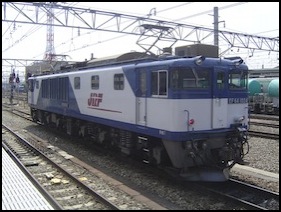
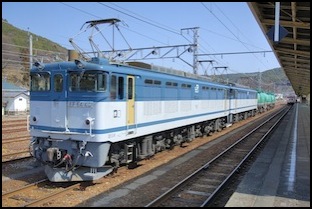
Left: JRF EF64-124 in refurbished, late livery (2006), and Right: JRF EF64-43 in refurbished, early livery (2009)
Photographers: Kone and : 出々 吾壱
Specifications:
Type: EF64
Built: 1965 - 1982 (class prototype in 1964)
In use: 1965 - present (being retired)
Top Speed: 100 kph
Power: 2.55 MW (3,420 hp)
Type: electric, 1500 V DC catenary
Weight: 96 t
Use: Freight and Passenger (limited use)
Assigned: Tabata, elsewhere?
EF65, EF65-500, EF65-1000
The EF65 is very similar in capability to the EF64, although they look quite different in detail. Three series were built, the EF65, EF65-500 and the EF65-1000 (train numbers reflect the series). Examples of all remained in use until recently. However, the EF210 is largely replacing the remaining freight units.
The EF65-500 series was designed for high-speed passenger and freight trains, and two subseries (identified as “P” and “F”) were built. The EF65 and EF65-1000 series were general-purpose, and used for both passenger and freight. The EF65-1000 series is distinguished from the others by an end door, located between the split windshields.
Unit 1118, one of two JR East EF65-1000 units painted red for a Super-Express passenger train discontinued in 2000, is now assigned to Tabata Depot and used for work trains and freight (the other unit was scrapped).
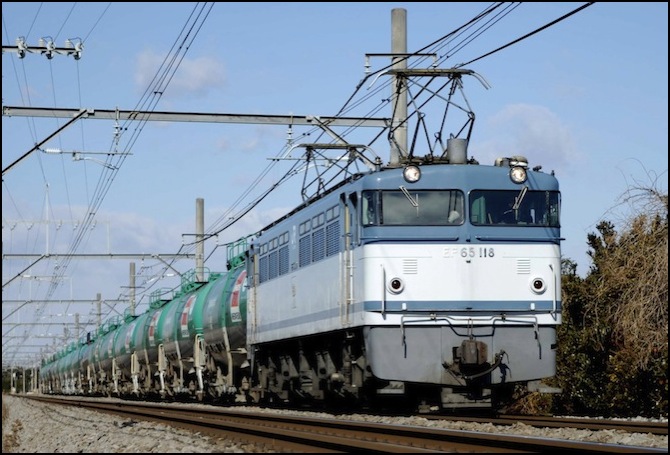
JRF EF65-118 #118 (2008)
Photographer: Sui-Setz
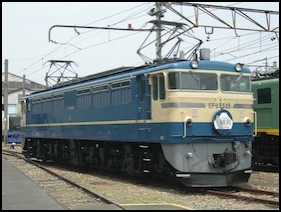
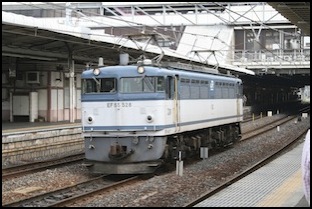
Left: JRF EF65-500 $535 (2008), Right: JRF EF65-500 #528 (2009)
Photographers: Rsa and 韋駄天狗
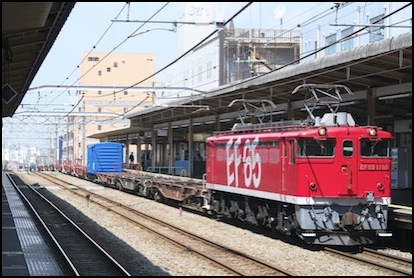
JRE EF65-1000 #118 at Nishi-Kokubunji Station in “JR East Super-Express Rainbow” livery (2008)
Photographer: Rs1421
Specifications:
Type: EF65
Built: 1965 - 1979
In use: 1965 - present (being retired)
Top Speed: 110 kph (115 kph design maximum)
Power: 2.55 MW (3,420 hp)
Type: electric, 1500 V DC catenary
Weight: 96 t
Use: Freight and Passenger
Assigned: Tabata, ?
EF66. EF66-100
The EF66 was developed for high-speed freight use, and remains in use on the Tōkaidō Line. Two series were built, and the differences between them are mainly stylistic. Series 0 units (numbered 1 - 55) and series 100, built after 1989 by JR Freight due to continued demand for use in intermodal trains (these were numbered 101 - 133). As of 2006 JR Freight still had 75 units (from both series), but this had decreased to 63 in 2009. Although not assigned to Tokyo, I have seen pictures of them within the Metropolitan Area, so they operate into it at least occasionally. These are gradually being replaced by EF210 locomotives, per the Japanese Wikipedia page.
The original series actually had two slightly different designs. The first 20 lacked the “eaves” above the windshield (as seen on #37, below, one of the later design models). The models produced in 1990 and 1991 (109 - 133) have a blue band around the lower body and a silver headlight surround (as seen below), both details missing on models 101 - 108.
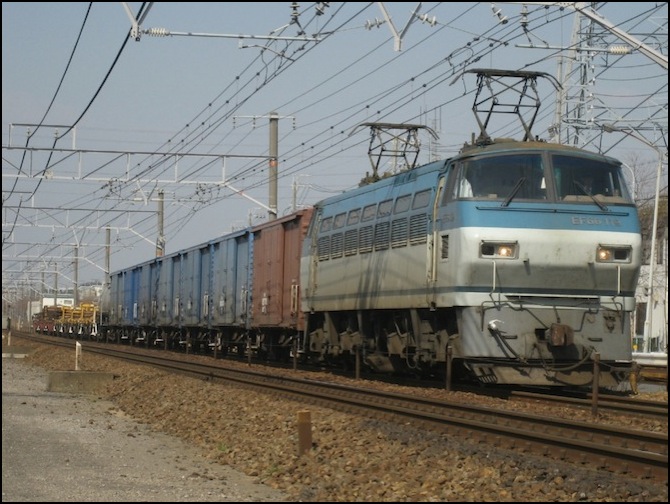
JRF EF66-100 #119 (2007)
Photographer: 継之助
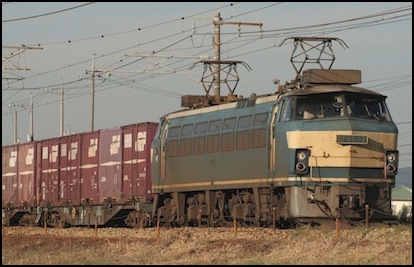
JRF EF66 #37 (2007)
Photographer: Mitsuki-2368
Specifications:
Type: EF66
Built: 1968 - 1974 (series 0), 1989 - 1991 (series 100)
In use: 1968 - present
Top Speed: 110 kph
Power: 3,900 kW (5,230 hp)
Type: electric, 1,500 V DC, catenary
Weight: 100.8
Use: Freight and Passenger
Assigned: JRF units to Suita Depot (Osaka), JR West units at Shimonoseki Depot (far western Japan)
EF81
The EF81 is a dual-voltage locomotive, and with 50/60 Hz support, it is one that can run in both regions of Japan (west and north). Several different series were produced, some for specialized tunnel use in Western Japan. Although JR Freight owns many of these, they appear to all be assigned to Toyama Depot, for use along the Sea of Japan coast (per the Japanese Wikipedia page). There is at least one assigned to Tabata Depot, but these are probably JR East units used on passenger trains.
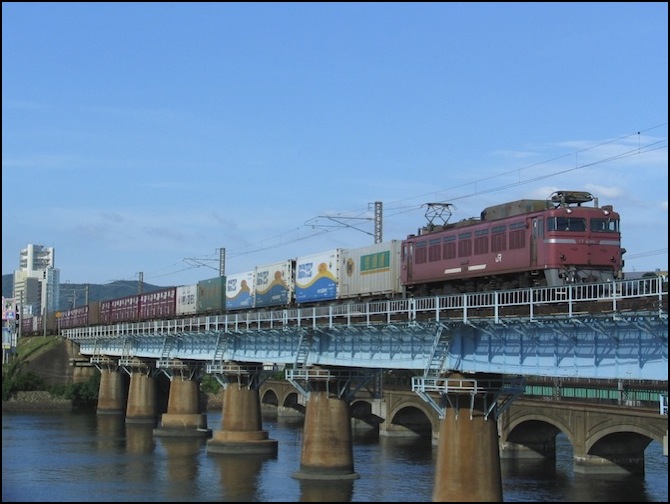
JRF EF81 #405 (2007)
Photographer: にゆうてい (Niyute)
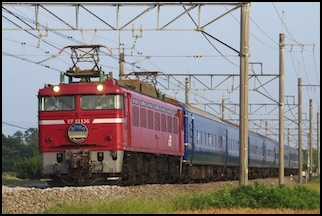
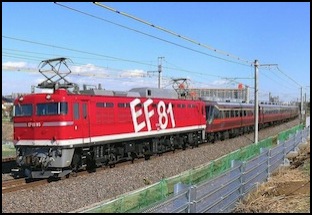
Left: JR East EF81 #136 leading Akebono (2007), Right: JR East EF81 #95 (2007)
Photographers: Sui-setz and まも(Mamo)
Specifications:
Type: EF81
Built: 1968 - 1979, 1989 (series 500), 1991 (series 450)
In use: 1968 - present
Top Speed: 110 kph
Power: DC: 2,550 kW (3,420 hp), AC: 2,370 kW (3,178 hp)
Type: electric, 1,500 V DC / 20 kV AC (50/60 Hz), catenary
Weight: 100.8 t
Use: Freight and Passenger
Assigned: JR East: Tabata Depot, elsewhere; JR Freight: Toyama Depot
EF210 / EF510
The EF210 was produced in two series, the original EF210 and the EF210-100. The latter is distinguished by its single-arm pantograph, and has internal differences also. Around Tōkyō, they are primarily used on the Tōkaidō Main Line, replacing older EF65 and EF66 units. Every photo I have found shows them pulling container trains.
An EF210-301 series is being developed for use as a pusher replacing some remaining EF67 uses in 2012. It may also be used more generally as a freight locomotive.
The EF510 dual-voltage (AC/DC) passenger locomotive is very similar to the EF210, and re-used many parts from it. It was also produced in two series, EF510-0 and EF510-500. JR Freight has a number of EF510 series 0 locomotives, although it is unclear if any operate into Tokyo. It’s possible, as the Tōhoku Main Line requires dual-mode power for long-distance trains; however the Japanese Wikipedia page seems to indicate that they are assigned to Toyama Depot, on the Sea of Japan coast and that EH500 locomotives are used on the Tōhoku Main Line instead. The series 0 units are painted red, and bear a “Red Thunder” logo.
JR East has been purchasing EF510-500 series locomotives to replace their fleet of EF81 units used to haul passenger cars, including overnight sleeper trains (one was painted in a blue Hokutosei paint scheme, and two in silver Cassiopeia colors). At least some of these locomotives are assigned to Tabata Depot.
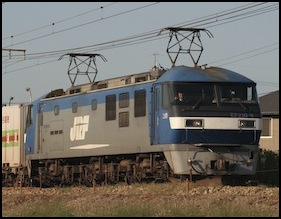
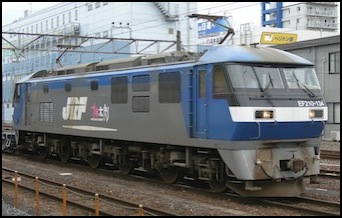
Left: JRF EF210 #9 (2007), Right: JRF EF210-100 #134 (2009)
Photographers: Mitsuki-2368 and Rsa
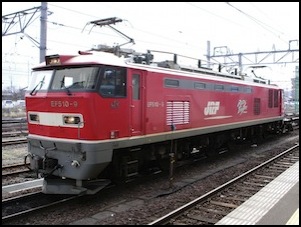
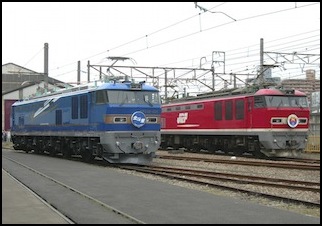
Left: JRF EF510 #9 (2007), Right: JRF EF510-500 #501 and EF510 #1 at Ōmiya (2010)
Photographer: Rsa (both)
Specifications:
Type: EF210
Built: 1996 - present
In use: 1996 - present
Top Speed: 110 kph
Power: 3,390 kW (4,546 hp)
Type: electric, 1500 V DC, catenary
Weight: 100.8 t
Use: Freight
Assigned: Okayama (all EF210 plus some EF210-100), Shin-Tsurumi (Tōkyō) and Suita (Osaka) Depots
Type: EF510
Built: 2001 - present (series 0), 2010 - present (series 500)
In use: 2002 - present (series 0), 2010 - present (series 500)
Top Speed: 110 kph (maximum design speed 120 kph)
Power: 3,390 kW (4,546 hp)
Type: electric, 1500 V DC / 20 kV (50/60 Hz), catenary
Weight: 100.8 t
Use: Freight (series 0), Passenger (series 500)
Assigned: Toyama Depot (series 0), Tabata Depot (series 500)
EH200 / EH500
The EH200 and EH500 are similar locomotives. Both are in the form of permanently-coupled pairs, the EH200 being the DC-only model, and the EH500 being the dual voltage AC/DC model. The EH200 bears a “Blue Thunder” logo.
The EH200 is primarily used on the Chūō Main Line, as motive power for oil tank trains from Tōkyō. Each EH200 replaces a pair of EF64 locomotives.
The EH500 is primarily used on the Tōhoku Main Line for container trains from Tōkyō. EH500 models prior to #10 were painted a dark red, later models are in a bright red. While the EH500 locomotives have been used to haul trains through the Seikan tunnel to Hokkaido, they are being replaced in this role by the new EH800, designed to function on the 25kV Shinkansen power supply used in the upgraded tunnel. The new locos will only operate in the vicinity of the tunnel, so EH500s should remain in use on the dual-voltage line to Tōkyō.
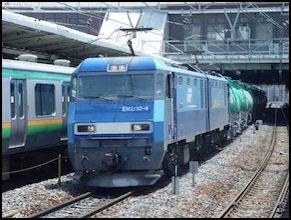
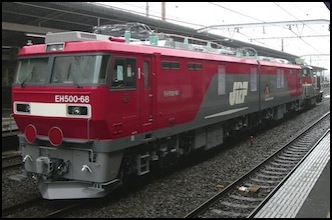
Left: JRF EH200 #4 at Ōmiya (2005), Right: JRF EH500 #68 (2010)
Photographers: D A J Fossett, Rsa
Specifications (for coupled pair):
Type: EH200
Built: 2001 - present
In use: 2001 - present
Top Speed:
Power: 4,520 kW (6,061 hp)
Type: electric, 1500 V DC, catenary
Weight: 134.4 t
Use: Freight
Assigned: Takasaki Depot
Specifications:
Type: EH500
Built: 1997 - present
In use: 1997 - present
Top Speed: 110 kph
Power: 4,000 kW (5,364 hp)
Type: electric, 1500 V DC / 20 kV (50/60 Hz), catenary
Weight: 134.2 t
Use: Freight and Passenger
Assigned: Tabata, Sendai Depots
EH800
The EH800 is a new electric locomotive being developed for use through the Seikan tunnel linking the Japanese mainline with the northern island of Hokkaido. A prototype is due to be delivered in 2012 for evaluation, with full operation due in 2015 when use of the tunnel by Shinkansen commences. These will operate between Aomori in Aomori prefecture and Hakodate Freight Terminal in Hakodate, Hokkaido. Information is, as yet, extremely scarce. See this blog entry for the below wire-frame diagram (my copy came from the original PDF) and some Japanese description, with this one slide apparently providing all the known information, which is that it will include a radio compatible with the Shinlkansen system, support a digital form of Advanced Train Control signaling, and some kind of emergency stop system related to catenary problems, as well as being dual-voltage AC (20/25 kV). The prototype unit is/will be numbered EH800-901.
The graphic released by MLIT looked much like an EH500, and it’s likely built on the same basic design, since that has been successful over its 15 years of existence. Press images show it in red, similar to an EH500 but without the gray panel, and with a wavy silver stripe down the side.
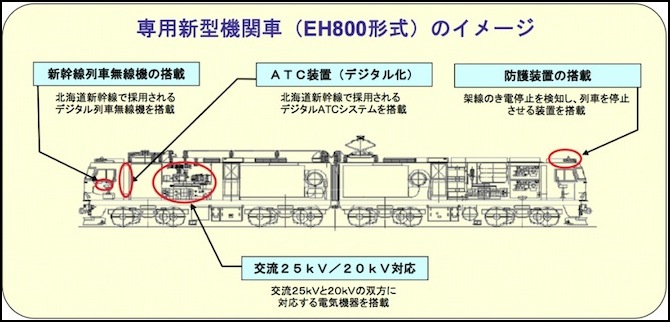
Graphic of EH800 from a MLIT subcommittee meeting (2012)
Assumed copyright (but none given) and used under Fair Use exemption
Note: the three text boxes on top point out (L to R) the radio, digital ATC and catenary protection, the box below notes dual-voltage support.
Specifications:
Type: EH800
Built: prototype due 2012
In use: operation due 2015
Top Speed: 200 kph?
Power: (I’ve seen a blog post that said 6,000 kW, possibly speculative)
Type: dual-voltage 20kV/25kV 50Hz AC, catenary
Weight: unknown
Use: Freight
Assigned: unknown
M250 Super Rail Cargo
The M250 is a nearly unique (two sets were built) container EMU (electric multiple-unit) train, used on a high-speed overnight freight, the Sagawa Express, from Tōkyō to Ajikawaguchi Station in Osaka. The trip takes 6 hours and 10 minutes each way, for an average speed of 91 kph (57 mph). Each set of 16 semi-permanently-coupled cars includes four motor cars (two at each end) that can carry a single 31-foot U54A container, plus six pairs of T260/T261 flatbed cars that can carry two 31-foot containers per car, for a total capacity of 28 containers. It appears that the containers can be loaded to 9.5 tons each, except for the end containers which can be loaded to 11.5 tons. This matches the description of the container (Japanese wikipedia) as having a maximum loaded weight of 11.5 tons.
There are (apparently) two sets of trailers, and three sets of motor cars (presumably the third set is to allow maintenance without disrupting train operations).
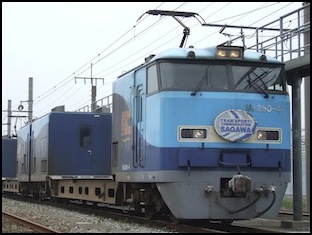
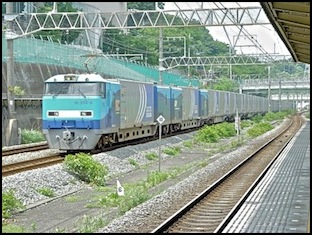
Left: M250 Cab unit (2007), Right: M250 at Higashi-Totsuka station (2003)
Photographers: Lover of Romance, D A J Fossett
Type: M250
Built: 2003
In use: 2004 - present
Top Speed: 130 kph (81 mph)
Power: 3,520 kW (4,720 hp)
Type: electric, 1500 V DC, catenary
Weight: 406.t (all cars total)
Use: Freight
Assigned: Oi District Authority (Tōkyō Freight Terminal)
Diesel Locomotives
Although JRF has other diesel locomotives, I originally thought that only the DE10 and industrial switches were likely to be encountered around Tōkyō. However that’s no longer true (if it ever was), as I’ve seen repeated references to the DE11 being used at Kawasaki Freight Yard and elsewhere. Additionally the HD300 was tested there also.
DE10
The DE10 us the workhorse of JRF (and other JR company) yards and branch lines, and models are operated by other railways as well. It has five axles due to the need to operate on lightweight branch lines, and uses an hydraulic transmission, rather than the electric traction motors driven by a generator used by most diesel locomotives. Early models included a steam boiler for heating passenger cars, but this was replaced on later models (all remaining in-service ones?) with a concrete block for improved traction.
Three main series were produced, with unit numbers reflecting the series. The 500 series (501 - 574) were 1,250 hp models that did not survive the end of JNR (some apparently went to private railroads); the 1000 series (1001 - 1210) had upgraded engines (1,350 hp), and the 1500 series (1501 - 1765) produced from 1970 - 1977 did also. JR East has also apparently converted some surplus DE15 locomotives into DE10 models, and numbered them in the 3000 and 3500 series. Of JR Freights original 151 units, 118 remained in service as of February 2011. Of JR East’s original 68, 34 remained in service as of April 2010.
The three-axle truck has axles that can independently move to reduce friction on curves and ensure even weight loading. Per the Japanese wikipedia page, this means that is would be described as a AAA-B locomotive rather than a C-B.
JR has used several paint schemes for the DE10, the most current appears to be the one shown at the upper left below: gray lower body, red upper body, and gray roof. Several locomotives that wore the blue and gray colors as recently as 2009 have been repainted into this color in 2010. The red lower-body, gray upper-body & roof scheme shown in the large picture below is somewhat older, possibly dating back to JNR (pre-1987) although some locomotives still bear it today.
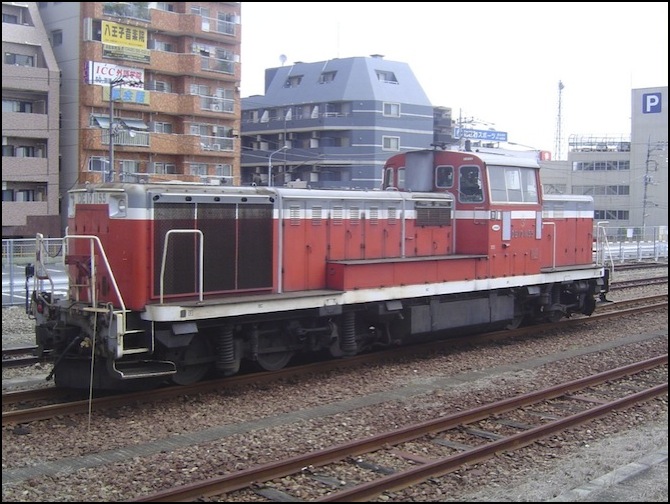
JRF DE10 #1155, Hachioji Station (2006)
Photographer: Kone
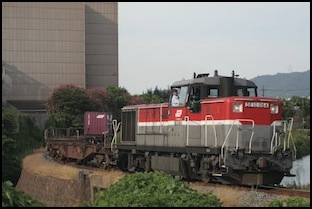
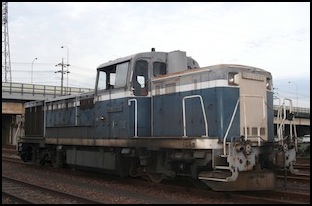
Left: JRF DE10 #1164, Mizushima Railway Museum (2009), Right: JRF DE10 #1733 (old color) (2007)
Photographer: Mitsuki-2368 が撮影 (both)
Specifications:
Type: DE10
Built: 1966 - 1978
In use: 1966 - present
Top Speed: 95 kph
Power: 1,350 hp
Type: diesel-hydraulic
Weight: 65 t
Use: Freight and Passenger
Assigned: everywhere
DE11
The DE 11 was developed by JNR for freight-handling duties that required more traction than the DE10 could provide (DE10 901 was used as a prototype), and later passed to JR Freight. These omitted the steam generator found on some DE10 models. JR East apparently employs or did employ some as well. Information on these is scarce (and I omitted them from my list for a long time, thinking it was a reference to a sub-class of DE10). This appears to be an AAA-B truck design (all three axles on one end independently driven) rather than the A1A-B design used on the DE10 (two of the three axles driven).
The original Series 0 models have all been scrapped. The 1000 series was constructed starting in 1969, with slightly higher horsepower. A total of 46 were produced, and some apparently remain in use. Unit 1901 was produced in 1974 as a low-noise model for use in freight yards closely abutting residential areas, and scrapped in 2000. This was the first to have cab air-conditioning. Four more low-noise models, identified as series 2000, were produced from 1979. These apparently remain in service.
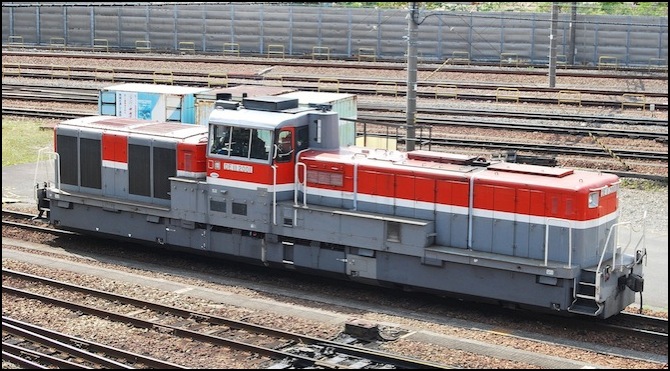
JRF DE11-2001 at Yokohama-Hazawa Station (2011)
Photographer: toshinori baba
Specifications:
Type: DE11 (Japanese wikipedia)
Built: 1967 - 1979+
In use: 1967 - present
Top Speed: 95 kph?
Power: 1,250 hp (series 0) / 1,350 hp (series 1000) / 1,350 hp? (series 2000)
Type: diesel-hydraulic?
Weight: 70 t
Use: Freight and Passenger
Assigned: everywhere
HD300
The successor to the DE10 has been a long time coming. The youngest DE10 is 32 years old as of 2011, and most of the last series produced are approaching 40 years of age, when locomotives are typically retired in Japan. JR Freight has taken the lead on replacing the DE10, working with Toshiba to develop a cleaner, more efficient, lightweight diesel locomotive. The result, the HD300-901 prototype, was in testing from 2010, with the first production unit, HD300-1, in service in February 2012. Production of additional units to replace DE10’s is expected shortly.
The HD300 is what would be called a “genset” locomotive in North America; a small diesel engine charges batteries, which drive electric traction motors on the axles. Regenerative brakes also charge the batteries (which are lithium-ion technology, rather than the more common lead-acid). This approach allows a smaller engine to be used for the same tasks, and when not charging the battery the diesel engine shuts down. This reduces both noise and fuel consumption. Top speed is reportedly 110 kph, although the Japanese wikipedia page describes that as applying “when routed”, which may mean that it’s the allowed top speed when pulled by another locomotive. The page lists 45 kph “when powering”, suggesting that that’s its top speed under its own power.
JR East also has a Hybrid DMU (Japanese wikipedia) being tested as of 2010, but not around Tōkyō.
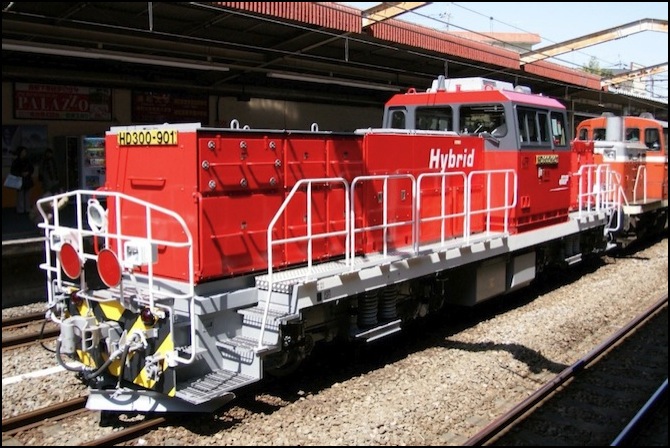
JRF HD300 Prototype #901, at Shin-Akitsu Station (2010)
Photographer: D A J Fossett
Specifications:
Type: HD300
Built: 2011+ (prototype delivered 2010)
In use: 2011+
Top Speed: 45 kph / 110 kph
Power: 500 kW (671 hp)
Type: hybrid (diesel/battery)
Weight: 60 t
Use: Freight
Assigned: Tōkyō




